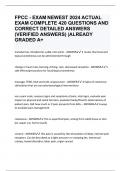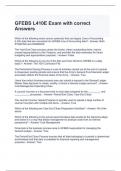FPCC - EXAM NEWEST 2024 ACTUAL
EXAM COMPLETE 420 QUESTIONS AND
CORRECT DETAILED ANSWERS
(VERIFIED ANSWERS) |ALREADY
GRADED A+
transdermal, intradermal, subQ, into joints - ANSWER✔✔ 4 routes that local and
topical anesthesias can be administered through
change in heart rate, burning, itching, rash, decreased sensation - ANSWER✔✔ 5
side effects/precautions for local/topical anesthesia
massage, TENS, heat and cold, acupuncture - ANSWER✔✔ 4 types of cutaneous
stimulation that are non-pharmacological interventions
use a pain scale, reassess signs and symptoms of pain, vital signs, evaluate pain
impact on physical and social function, evaluate family/friend's observations of
patient pain, ASK how much or if pain prevents from ADLs - ANSWER✔✔ 6 ways
to evaluate pain management
cutaneous - ANSWER✔✔ this is superficial pain, arising from subQ tissue or skin
(ex. paper cut, hot to touch)
visceral - ANSWER✔✔ this pain is caused by the stimulation of deep, internal pain
receptors. Can be described as a tight pressure or cramping (ex. menstrual
cramps, bowel disorders, labor pain, organ cancer)
,deep somatic - ANSWER✔✔ this pain originates in ligaments, tendons, nerves,
blood vessels, and bones. Localized and described as achy or tender. (ex. fracture,
sprain, arthritis, bone cancer)
psychogenic - ANSWER✔✔ this pain is believed to originate from the mind;
patient perceives pain despite no physical cause that can be identified.
visceral, somatic - ANSWER✔✔ two types of nociceptive pain are ___ and ___.
neuropathic - ANSWER✔✔ type of pain that is a complex and often chronic pain
that arises when injury to one or more nerves results in repeated transmission of
pain signals even in the absence of stimuli.
acute - ANSWER✔✔ which type of pain is protective- acute or chronic?
whenever you take full set of vitals (routinely) - ANSWER✔✔ when should pain be
assessed on patient?
patient self report - ANSWER✔✔ what is the most reliable way to assess patient
pain?
mild, moderate or severe - ANSWER✔✔ nonpharmacological interventions are
good alternatives if experiencing ___ pain, but should be used as complementary
interventions if pain is __ or ___.
,heat - ANSWER✔✔ ___ promotes circulation, which speeds healing.
contralateral stimulation - ANSWER✔✔ stimulating skin in area opposite of the
painful site
localized, diffuse - ANSWER✔✔ cutaneous stimulation is best for pain that is ___
and not ___
visual (watch TV), tactile (touch, stroking a pet), intellectual (puzzle), auditory
(music therapy) - ANSWER✔✔ 4 types of distraction that can use to help distract
from pain
guided imagery - ANSWER✔✔ uses auditory and imaginary processes to affect
emotions and help calm, divert, and relax.
diaphragmatic - ANSWER✔✔ what type of breathing promotes relaxation
opioids - ANSWER✔✔ kind of medication we should give if patient is in severe
pain
n/v, constipation, itching, breakouts - ANSWER✔✔ 4 common side effects seen
with opioid use
2 nurses - ANSWER✔✔ who does PCA have to be checked by before giving?
, increases circulation, lowers BP, improves venous return, healthy heart rate at
resting level - ANSWER✔✔ 4 cardiovascular benefits of mobility
RR comes to healthy rate faster, better oxygenation, helps diaphragmatic
breathing - ANSWER✔✔ 3 pulmonary benefits of mobility
hypostatic pneumonia - ANSWER✔✔ this is when infection occurs from pooling
secretions (seen with immobility)
tracheal deviation and unilateral chest expansion - ANSWER✔✔ 2 things you may
see if patient experiences atelectasis due to a mucous plug or secretion block. (no
ventilation)
parathyroid - ANSWER✔✔ With immobility, ___ gland issues are common due to
hypercalcemia and there's an increased release of Ca from bones.
footdrop - ANSWER✔✔ joint contracture of immobility when the foot
permanently drops into plantar flexion
UTI - ANSWER✔✔ during immobility, urine can pool in the pelvis when laying
down and increases the risk for developing ___
kidney stones - ANSWER✔✔ another name for renal calculi is
disease (disorders and injuries), environment (workplace, school, community,
family support), medical therapies (bed rest, splints/casts, restraints) -





